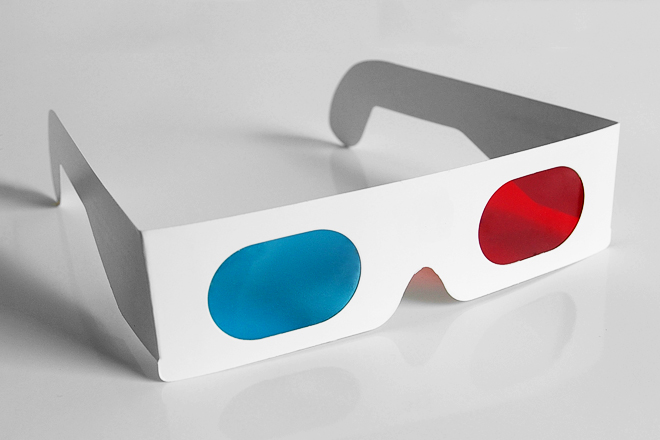How stereoscopic 3D is problematic
Published: 01 Aug 2010
There has been a growing trend in creating 3D stereoscopic films in the last 2 years, and I fear it is only spreading to other screen based mediums such as T.V. and Video Gaming. Other than the fact that nearly 1 in ten people will have problems enjoying a 3D films due to vision differences, there are other facts that I feel are more fundamental to the viewing experience.

Stereopsis and depth perception
There are several visual cues your eyes use to evaluate a scene. One of these can be described as Stereopsis – the creation of depth by the difference between each eyes stimulus. Combined with the ability to shift focus, your eyes can identify distance in a scene.
In 3D stereoscopic cinema your eyes are presented with two different images (synchronise projection) or a single image combining the two with filters to make the separation (the different hue glasses). When presented with stimulus your eyes create distance using Stereopsis, but cannot shift the images focus, this creates a nauseating feeling. As the viewer is unable to focus on different elements of the picture the film effectively leads you around the screen. In the trend for this technology to be used in high budget action movies where the motion occurs at a faster pace, it can be especially difficult to keep up with the point of 3D focus the filmmaker has created. This is contrary to traditional cinema where your point of focus is more like glimpsing a painting, a 2D representation of a 3D environment, which allows your eyes to glide around the picture effectively choosing your own screen narrative with out the need to strain focus as it stays constant. 3D is effectively nearly real enough to be confused with real, but not real enough to pass as real – Freud’s Uncanny Valley.
The illusion of cinema
The next problem is that of the screen itself. The screen is a window; it has dimensions, a projected scene, and mimics our visual breadth. However it doesn’t provide the viewer with periphery stimulus (unlike the full-dome), thus the flat small dimensional screen is condemned to acting like a window: a window into a new space or environment. Without periphery information and the obvious screen extremities, it becomes apparent when a visual actor hits the edge of the screen, or leaves the viewing space. As traditional 2D cinema acts like a window, the introduction of the 3rd dimension, which creates images that protrude the screen, is problematic.
In 2D when a visual actor hits the edge of the screen they are perceived as dropping out of view of the window (imagine seeing people walking by the window of a coffee shop as you’re watching from the inside), in 3D the visual actor is protruding the screen creating the illusion that something has come through the screen (like someone walking into the coffee shop). However when that actor hits the edge of the screen, now the illusion is broken (the person walks through a wall). Whenever 3D focus is pulled to a visual actor surrounded by screen in the scene, then the 3D effect is continuous, but when they find an edge a once whole visual actor is erased by the screen edge itself.
Solutions?
With this said there are some interesting developments in technology that can enable other types of 3D viewing. There is head tracking within gaming, which follows the user’s head movements and adjusts the angle of view respectively, tricking the viewer into believing there is a 3D environment – as objects can be viewed from different angles as part of your depth perception. 3D, like that of head tracking, which can also be found in the 3DS, Nintendo’s new handheld gaming device, utilises the screens inherent nature to be window like, and instead of having 3D elements jump out of the screen, they are set back into it – as if you were looking down into a much larger box.
3D, I believe should be taken responsibly, like alcohol, not every film please. Also please think more about the experience and not just setting standards up, and hoping it’ll be the next filmic capitalist machine.
Now my head hurts.
Original essay written for Huhmagazine: http://www.huhmagazine.co.uk/1566/3d-cinema-is-here-%28again%29